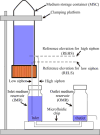A hydrostatic pressure-driven passive micropump enhanced with siphon-based autofill function
- PMID: 29931005
- PMCID: PMC6057814
- DOI: 10.1039/c8lc00236c
A hydrostatic pressure-driven passive micropump enhanced with siphon-based autofill function
Abstract
Autonomous and self-powered micropumps are in critical demand for versatile cell- and tissue-based applications as well as for low-cost point-of-care testing (POCT) in microfluidics fields. The hydrostatic pressure-driven passive micropumps are simple and widely used, but they cannot maintain steady and continuous flow for long periods of time. Here, we propose a hydrostatic pressure-driven passive micropump enhanced with siphon-based autofill function, which can realize the autonomous and continuous perfusion with well-controlled steady flow over an extended time without electric power consumption. The characterization results reveal that both the cycle number in one refilling loop and the siphon diameter will affect the refilling time. Furthermore, this micropump also enables multiplexed medium delivery under either the same or different flow conditions with high flexibility. The system was validated using an in vitro vasculogenesis model over the course of several days. Most importantly, the device can consistently provide steady medium perfusion for up to 5 days at a predefined hydrostatic pressure drop without the need for supplemental medium changes. We believe that this hydrostatic pressure-driven passive micropump will become a critical module for a broad range of sophisticated microfluidic operations and applications.
Figures









Similar articles
-
A smart and portable micropump for stable liquid delivery.Electrophoresis. 2019 Mar;40(6):865-872. doi: 10.1002/elps.201800494. Epub 2019 Jan 16. Electrophoresis. 2019. PMID: 30628114
-
A pressure-driven gas-diffusion/permeation micropump for self-activated sample transport in an extreme micro-environment.Analyst. 2018 Oct 8;143(20):4819-4835. doi: 10.1039/c8an01120f. Analyst. 2018. PMID: 30229240
-
Passive Micropump for Highly Stable, Long-Termed, and Large Volume of Droplet Generation/Transport Inside 3D Microchannels Capable of Surfactant-Free and Droplet-Based Thermocycled Reverse Transcription-Polymerase Chain Reactions Based on a Single Thermostatic Heater.Anal Chem. 2018 Oct 16;90(20):11925-11932. doi: 10.1021/acs.analchem.8b02271. Epub 2018 Sep 28. Anal Chem. 2018. PMID: 30215252
-
Design of pressure-driven microfluidic networks using electric circuit analogy.Lab Chip. 2012 Feb 7;12(3):515-45. doi: 10.1039/c2lc20799k. Epub 2011 Dec 16. Lab Chip. 2012. PMID: 22179505 Review.
-
Pressure-driven microfluidic perfusion culture device for integrated dose-response assays.J Lab Autom. 2013 Dec;18(6):437-45. doi: 10.1177/2211068213503155. Epub 2013 Sep 6. J Lab Autom. 2013. PMID: 24014544 Review.
Cited by
-
Chips-on-a-plate device for monitoring cellular migration in a microchannel-based intestinal follicle-associated epithelium model.Biomicrofluidics. 2019 Dec 24;13(6):064127. doi: 10.1063/1.5128640. eCollection 2019 Nov. Biomicrofluidics. 2019. PMID: 31893012 Free PMC article.
-
Simultaneous Droplet Generation with In-Series Droplet T-Junctions Induced by Gravity-Induced Flow.Micromachines (Basel). 2021 Oct 4;12(10):1211. doi: 10.3390/mi12101211. Micromachines (Basel). 2021. PMID: 34683262 Free PMC article.
-
Microfluidic Organoids-on-a-Chip: Quantum Leap in Cancer Research.Cancers (Basel). 2021 Feb 10;13(4):737. doi: 10.3390/cancers13040737. Cancers (Basel). 2021. PMID: 33578886 Free PMC article. Review.
-
Rapid antimicrobial susceptibility tests performed by self-diluting microfluidic chips for drug resistance studies and point-of-care diagnostics.Microsyst Nanoeng. 2025 May 28;11(1):110. doi: 10.1038/s41378-025-00938-y. Microsyst Nanoeng. 2025. PMID: 40425590 Free PMC article.
-
Open-source pneumatic pressure pump for drop-based microfluidic flow controls.Eng Res Express. 2023 Sep;5(3):035014. doi: 10.1088/2631-8695/ace299. Epub 2023 Jul 12. Eng Res Express. 2023. PMID: 39649444 Free PMC article.
References
-
- van Duinen V, Trietsch SJ, Joore J, Vulto P, Hankemeier T. Curr Opin Biotechnol. 2015;35:118–126. - PubMed
-
- Bhatia SN, Ingber DE. Nat Biotechnol. 2014;32:760–772. - PubMed
-
- Hung PJ, Lee PJ, Sabounchi P, Aghdam N, Lin R, Lee LP. Lab Chip. 2005;5:44–48. - PubMed
-
- Studer V, Pepin A, Chen Y, Ajdari A. Analyst. 2004;129:944–949. - PubMed
-
- Bong KW, Chapin SC, Pregibon DC, Baah D, FloydSmith TM, Doyle PS. Lab Chip. 2011;11:743–747. - PubMed
Publication types
MeSH terms
Grants and funding
LinkOut - more resources
Full Text Sources
Other Literature Sources

